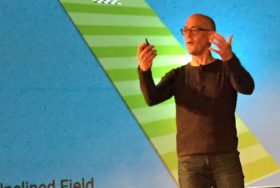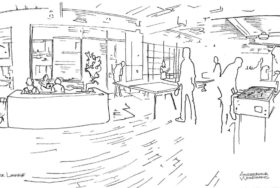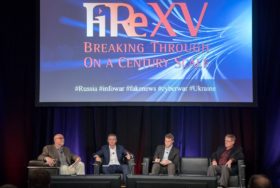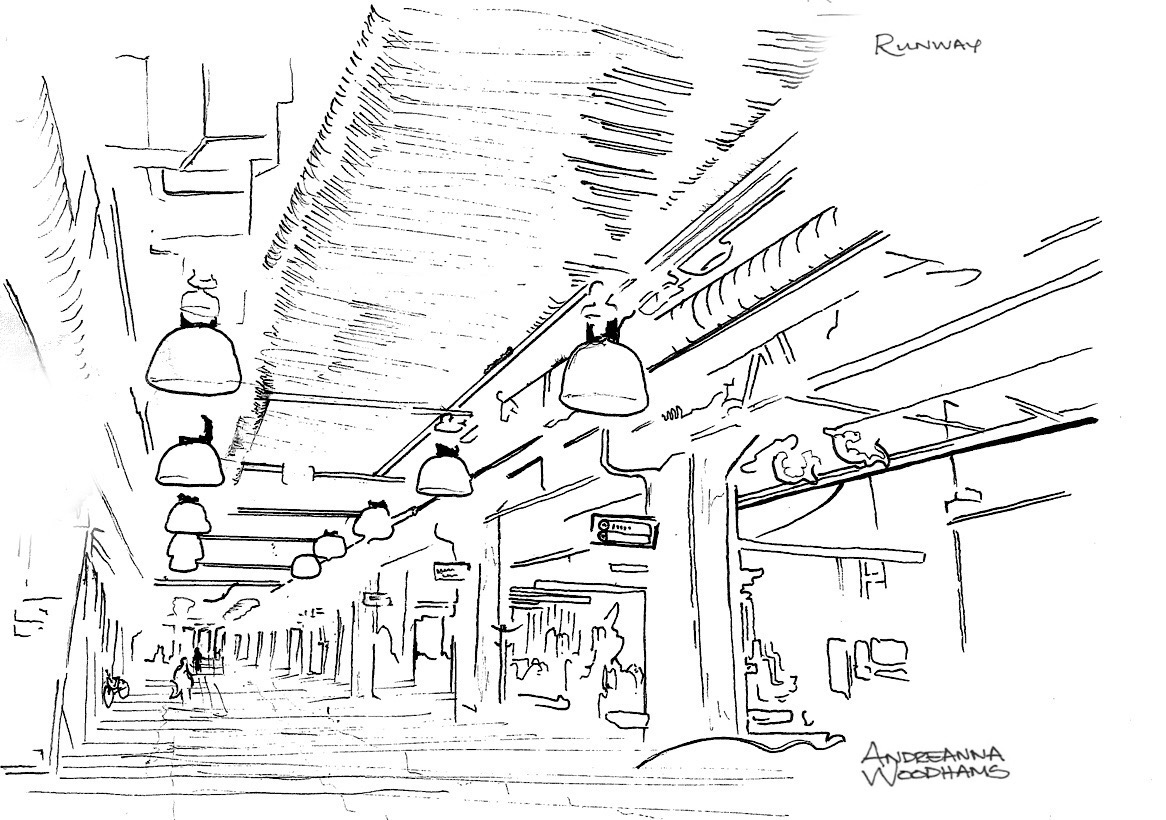
Runway, the stylish tech incubator in the Twitter building at 1355 Market Street, is the product of Allan Young’s experience and imagination. Allan is a Y Combinator alum, graduate of Seth Godin’s Alternative MBA Program, native of San Francisco’s Chinatown, and an active technology investor. This is our first in a series on local and international incubators and technology hubs, a deep dive into what makes early-stage startups and high-performing entrepreneurs tick. Andreanna Woodhams created the drawings. Jonathan Littman interviewed Allan Young. 如果您想看中文版本,请跳到最底页–本文由来自上海的王豪盛翻译
From Inspiration to Incubator
It was an honor and a privilege to be backed early on [as co-founder of a startup] by Y Combinator, one of the top accelerators in the world. My incredible learning experience there made a big difference. I noticed that there was such a strong culture with all the groups collectively, but we didn’t have much of a physical space to gather. We’d convene at Y Combinator’s office one evening a week, but I was craving more interaction with my fellow batch mates. [Allan was one of 30 startups in the Winter of 2010 Y Combinator “batch”.]
I wanted more connection. Many of the other teams had extremely talented technologists and entrepreneurs. I wasn’t so much looking to talk to them every hour, or every day. I just wanted to be in the same space, to see and to feed off of their speed and urgency – though, yes, of course we would talk. That one evening a week, getting updated on all the teams, was inspiring and motivating. It was also frightening. Some teams were moving so fast. It was like, “Wow, we have to step it up another notch.”
That was a huge influence in my decision to build an incubator. Another was hanging out with Seth Godin for a year, in 2009, as an inductee in Seth’s first Alternative MBA Program. We sat in his offices for five hours a day and talked. It was an informal program. We talked through lots of different MBA and non-MBA topics: Seth’s take on marketing, community, and giving gifts. None of it was textbook. Seth didn’t pay us and we didn’t pay him.
We learned so much, talking about community and sharing knowledge. Seth taught us about tribes, of having a common goal and purpose, and creating something valuable. I knew that in a tribal environment, community is essential to fostering a self-reinforcing culture.
Critical Decisions: Prime Location and Creative Design
Picking the location was less romantic. I thought we needed to be near mass transit. Once I knew that Twitter had committed to being in this building at 1355 Market Street, the justification was to follow and hitch a ride on a bigger whale. Twitter had already become a successful company. They had not IPO’d yet, but that was imminent. I knew that the Twitter location would attract clients, being in this building, being part of this watering hole.
Design was also a key decision early on. At Runway, there’s a physical runway. We designed it so that 50 percent of the square footage is desks. Approximately 50 percent is wide open – the runway, kitchen, igloo and event space.
I had visited other incubators and found them to be disappointing. The small ones particularly. They felt like shared offices, not really incubators. I noticed that there was very little interaction and sharing, and lots of private offices.
So I wanted to design a space where there was not one private office. Take an extreme view. This wouldn’t work for everybody. You don’t have your own room, the work environment is wide open. The idea was that you’d share ideas, knowledge, and lessons learned.
The open space is approximately equal to the workspace. We think there’s a golden ratio to that. If you’re a member of Runway, you can’t get to your desk without bumping into someone. If you’re social enough, inevitably you’ll share ideas. That’s the magic. With all these open spaces we create collisions – accidental collisions.
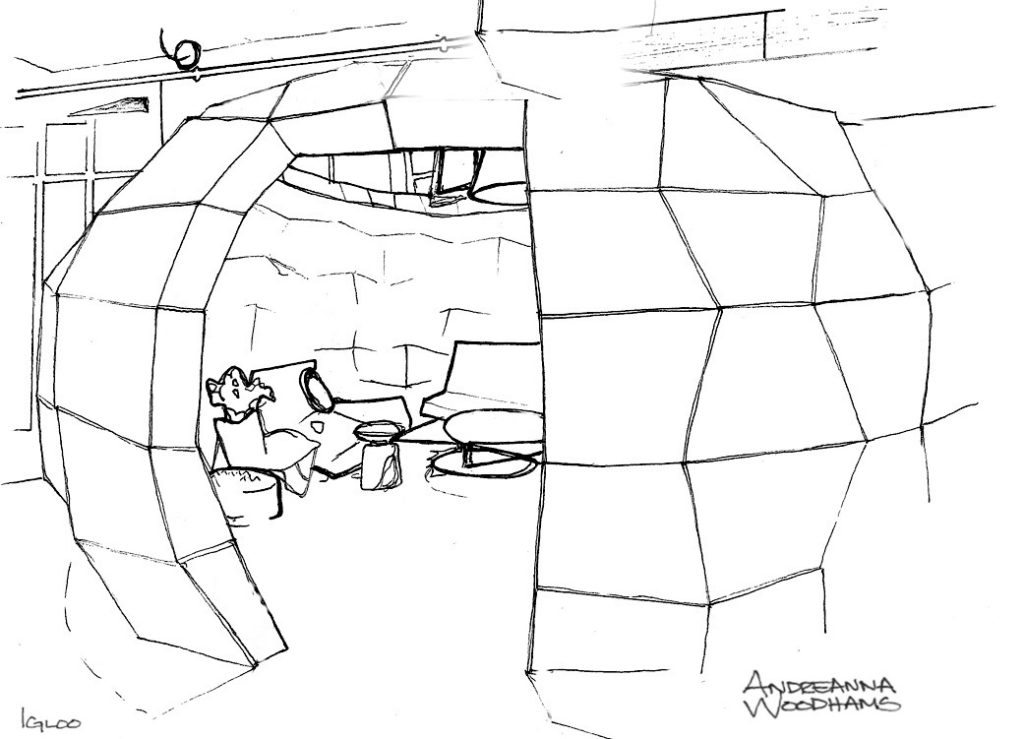
One big technical challenge was that it was this concrete shell that would have had massive echo and noise control issues. We worked with an architect and designer to minimize that, and I think they did an excellent job of solving that problem without making it too muffled or padded. We built three slatted wood canopies, and that small, unique design did soften the space a bit and added a visual touch. It’s highly functional: sound waves get trapped up there. We maintained the cold, harder feel, and that sense of speed, while eliminating the noise.
We knew that to design a space for productivity, we wanted to create different environments. The igloo, for example, is a shock to the cognitive senses. Sometimes it’s not enough to think differently. You might think more creatively if you’re in a different space. This was building off concepts found in Google and IDEO. If you’re stuck every day in the same place, your creativity can decrease. The igloo is a small, micro environment where you can get out of Runway without physically getting out of Runway. Based on feedback, it was pretty effective.
Growing a Culture
I don’t think I built the culture. I hired good people who are big fans of startups and entrepreneurs, people who are genuinely interested in entrepreneurship. We picked good teams. No assholes. They ended up building the culture. They created game night, where members played video games and board games. We had dynamic sessions on how to hack for growth. This was all initiated by the members. Within six months of our open date on January 13, 2013, Runway was full. We had over 80 teams and just over 200 people.
I don’t know if this would work for everybody, but we are generous with the communal space. Everyone who opens an incubator has this conflict. They’re trying to make the space pay for itself, and to maximize that, they have very little communal space. If you can charge for more workspace, you’ll have an easier time turning a profit. But I think the results and outcomes would be horrible. You’re putting everyone in a sardine can. We tried to be more liberal with our free, open space that we couldn’t charge money for. That’s number one.
Then we had to fill the space and attract a lot of good teams. We never bought an ad, online or offline. We didn’t go to other events to pitch Runway. Instead, we hosted as many events as we could that we thought would attract teams early on, and charged very little for the event space. That’s a growth hack. We started with my network, and once my network got to know Runway, the only way to expand was to run as many events as possible. This was another way of growing the culture.
The Realities of Real Estate
When you’re dealing with something physical, either hardware or real estate, things move slower than you anticipate. Real estate is super expensive and takes a long time. It’s shocking how much it costs to build out a new space. For the same money, I could have funded many startups.
I’d never managed a space or dealt with real estate. Running an incubator is a labor of love. You really need to have a lot of energy and put in a lot of hours, if you want a great outcome. You manage for the teams, you don’t manage for the incubator.
Runway’s Success Stories
We were very instrumental in helping the drone company Skycatch get its first couple of customers. That led to product validation and product development, and investment by Google Ventures. They’ve raised a lot of money [approximately $30 million]. They may bring about autonomous earth moving equipment. What Tesla and Uber may be to self-driving cars, Skycatch may be to the self-driving bulldozer.
DripStat started at Runway. DripStat is an application performance management platform created by one lone engineer who has built something exponentially better than the multi-billion leaders in his space. This is a great example of someone who came through Runway more for the interaction and the community. The company has had minimal funding, and I recently invested in them after they left Runway.
Learning from the Competition
I think Galvanize runs an excellent space. They’ve taken design to a whole new level. Runway was the design leader for incubators in Silicon Valley. Then when I saw Galvanize, I thought, wow, they’ve surpassed Runway. I’m generally against having multiple floors as they can create more separation and isolation. But Galvanize has the luxury of having several floors while physically having them feel connected because of cutouts in the upper floors and staircases that connect the levels in a visually prominent way.
Check out our second interview in the series, How We Work: Galvanize, The Startup Hive, and our third article, How We Work: Humanitarianism Meets Tech and Art at Swissnex.
About the Drawings
Andreanna Woodhams is an artist majoring in business administration at the University of San Francisco, interested in illustrative design, fine arts, and entrepreneurial thought. Andreanna was a student in my Creativity, Innovation and Applied Design class, where she was a key inspiration toward the development of a more visual, collaborative style of team prototyping and brainstorming.
我们是如何运作的:初创公司引擎Runway(T台)
Runway,这个坐落于1355市场大街的推特大楼里时尚的科技孵化器是Allan Young(杨尚仁)经验和想象力的产物。Allan是Y Combinator的校友,毕业于Seth Godin MBA项目,土生土长与旧金山中国城的Allan同时也是一位活跃的科技产业投资人。这是我们首次发布本地和国际化的孵化器和科技中心的系列采访,带领大家深入了解是什么成就了这些早期初创公司和高效企业家们。Andreanna Woodhams制作了绘画Jonathan Littman 采访了 Allan Young.
从灵感到孵化器
这是我的荣耀和荣幸在初期被Y Combinator支持(世界上最棒的加速器之一)。我在那里不可思议的学习经验带给了我很大的震撼。因为我注意到那里有着很强的集体团队文化,但是我们Runway却没有那么大的物理空间。我们每周在Y Combinator会聚一次但是我却渴望更多的交流与我们的同批队友。(Allan 是在Y Combinator 2010年冬季活动中30家初创公司之一)
我想要更多的交流。许多其他的团队有特别出色的技术专家和创业者。我不想每天每个小时都和他们谈话。我只想要处在这个环境中,去看和感受他们的速度和紧迫感,当然我们也会谈话。在Y Combinator每周晚上的一聚会是具有激励性和启发性的,各个团队会更新他们的进度。这让人非常震惊。一些队伍进展的太快了。这就像是提醒着我们“ wow,我们必须努力攀爬上另一个台阶。”
这段经历对我日后建立孵化器有重大影响。还有一段是我于2009年在Seth Godin学校呆的一年,作为Seth MBA项目应召者。我们每天在他的办公室五个小时讨论。这是一个不正式的项目。我们讨论内容包括了许多MBA和非MBA的话题:Seth在营销,社区和送礼上的见解。没有一项是在课本上的。全部内容都是免费的。
我们从中学习到很多,谈论内容从社区到知识分享。Seth教会我们关于“部落”:让有着共同的目标和目的的人在一起创造一些有价值的东西。我知道在一个部落的环境中,社区是培养自强文化的必要条件
关键的决策:出色的地点和创意的设计
选择一个地点并没有那么浪漫。我认为我们需要挨在交通便利的地方。当我知道推特选择入驻这栋位于1355市场街的大楼里面的时候,我的选择是搭上推特的顺风车。因为推特是一家非常成功的公司。虽然他们并没有上市但是那也是即将发生的事情。我知道推特的地点会吸引许多客人,如果能在这栋楼里多少也能沾到他们的光。
设计在早期是一件非常重要的决定。在Runway有一个真的T台走道。我们设计的是有百分之五十的空间是桌子。剩余的百分之五十空间是敞开的,这些包括了T台走道,厨房,圆顶小屋和活动空间。
我曾去过许多其他的孵化器并且发现其中有些让人失望。尤其是那些小的。他们给我的感觉像是一个小的公共办公空间并不像孵化器。我注意到他们很少有交流和分享还有许多私人办公室。
所以我想要设计一个完全没有私人办公室的空间。我选择了一个极端的方式,不一定适用于所有人。在里面的人不会有属于自己的房间,整个工作环境是开放的。这个设计是为了让你分享想法,知识,和所学到的经验教训。
这个开放空间几乎和工作空间一样大。我们认为这是一个黄金比例。如果你是Runway的一份子,你不可能走到自己的办公桌却一个人都遇不到。如果你有足够的社交,不可避免的你会交流想法。这就是魔术。在这些开放空间我们创造了碰撞—意外碰撞。
一个重大的技术挑战是,这是混凝土壳,将有大量的回声和噪声控制问题。我们和建筑师和设计师希望尽可能减少它,我认为他们出色的解决了这个问题的同时也没有让这里变的太沉闷。我们建立了三个板条木檐,这个很小独特的设计同时也让空间变的柔和一点,也增加了视觉的触摸。它的功能很强:声波被隔离在外面。我们保持了冷,硬的感觉,还有速度感,同时还消除噪音。
我们知道为了设计一个有效率的空间,我们想创造不同的环境。例如,圆顶小屋,是认知度非常高的的感官冲击。有时候很难去换个思维思考。如果你在不同的空间,你可能可以更富有创造性地思考。这是建立在谷歌和IDEO的概念。如果你每天坚持在同一个地方,你的创造力会降低。雪屋是小,微环境,你可以暂时离开Runway工作环境但是物理上不用离开Runway。基于反馈,这个设计还是非常有效的。
发展一种文化
我不认为我建立了文化。我雇佣了非常出色的人才,他们是创业和初创公司的粉丝是真正对创业感兴趣的人。没有混蛋。他们是真正建立文化的人。他们创办了游戏夜晚,会员们相聚在一起玩电子游戏和纸牌游戏。我们有一些动态的课程关于如何发展公司。这些都是我们的会员的提议。从2013年一月23日开始营业以来的半年Runway已经满了。我们有了超过80个队伍200多人。
我不能肯定Runway对所有人都有用,但是我们对公共空间很慷慨。所有开过孵化器的人都有这个问题。他们尝试让这个空间自给自足,然后可以的话充分利用这个空间,所以他们有很小的公共空间。如果你设立更多的工作空间这会让你很容易创造利润。但是我认为这么做的结果会很糟糕,你在把所有人放在一个沙丁鱼罐头里面。我们尝试给予我们不收费的的开放空间更多自由。这是第一要素。
这样我们慢慢吸引了许多非常出色的团队。我们从来没有在网上和现实中买任何广告。我们也没有去任何活动中去路演推销Runway。取而代之的是早期我们尽可能的举办所有我们能举办的活动来吸引优秀团队然后只收取活动主办方一点点费用。这是成长的秘诀。我们一开始是从我的个人的社交网络中起步的,当我社交网络内都知道Runway了以后,唯一能扩大知名度的方式就是举办活动。这是也另一种方式来发展文化。
房地产的现实
当你面对实物的时候,比如硬件或房地产,事物的发展会比你的预期慢很多。房地产是一个非常昂贵耗时的事情。需要建立一个新的场地的开销会让人震惊。用同样的钱我可以投资许多公司。
我从未管理过一个场地或是一个地产。管理一个孵化器是爱的劳动。如果你想有一个好的结果你需要花很多时间精力在上面。你要知道你的劳动是为了那些团队而不是为了这个场地。
Runway的成功故事
我们在Skycatch无人机公司找到第一批顾客上起到了很大的帮助。这直接助推了他们的产品验证和产品开发到后来被谷歌风投。他们已经募集了许多投资了(大约三千万美金)。他们可能会带来地球自动移动设备。特斯拉和优步可能会带来自动驾驶汽车,Skycatch可能会带来自动驾驶推土机。
DripStat是在Runway创立的。DripStat是一个应用性能管理平台,有一位工程师独立创作出来而且他所创造的应用比行业里面数十亿人都出色。这也是一个出色的例子关于一些人来Runway后积极的交流和沟通。这家公司有着很少的投资,他们离开Runway之后我便投资了他们。
从竞争中学习
我认为Galvanize是一个出色的空间。他们把设计提高到了一个新的高度。Runway是湾区中设计上的佼佼者。当我看到Galvanize的时候我认为,天哪他们超越了Runway。我一般不支持有着许多楼层的设计因为这样的话会区分区域并会造成分离的效果。但是Galvanize能够奢侈的拥有许多楼层的同时让人觉得整体是连接在一起的因为在楼层和楼梯的各方面设计上他们都创造了很好的过渡效果和视觉突出。
关于插画
Andreanna Woodhams是一位艺术家就读于旧金山大学工商管理学位,对于插画设计,美术,和创业思维有着浓厚的兴趣。Andreanna是我创意,创新和应用设计课的学生。她也是一个关键的启发者对于这种更加视觉直观,多协同风格的团队做原型和头脑风暴模式。
